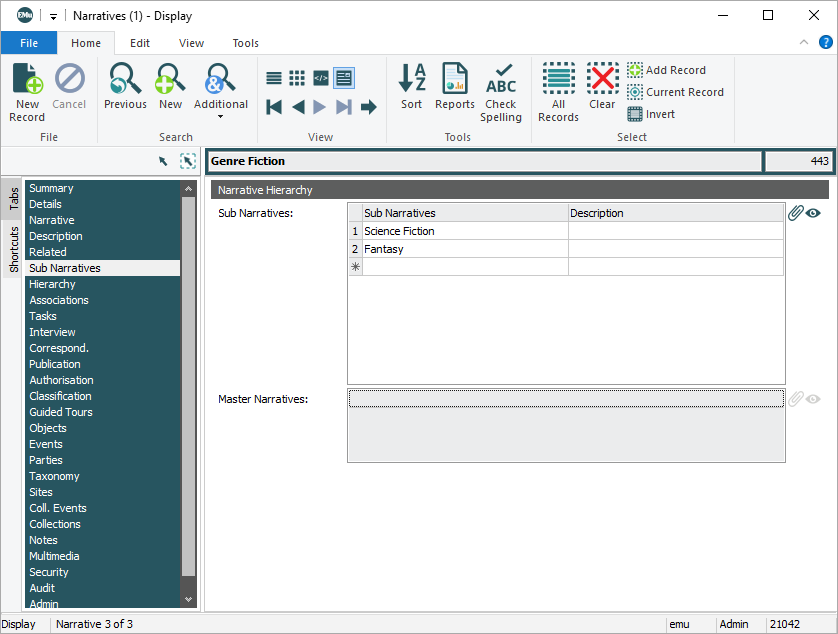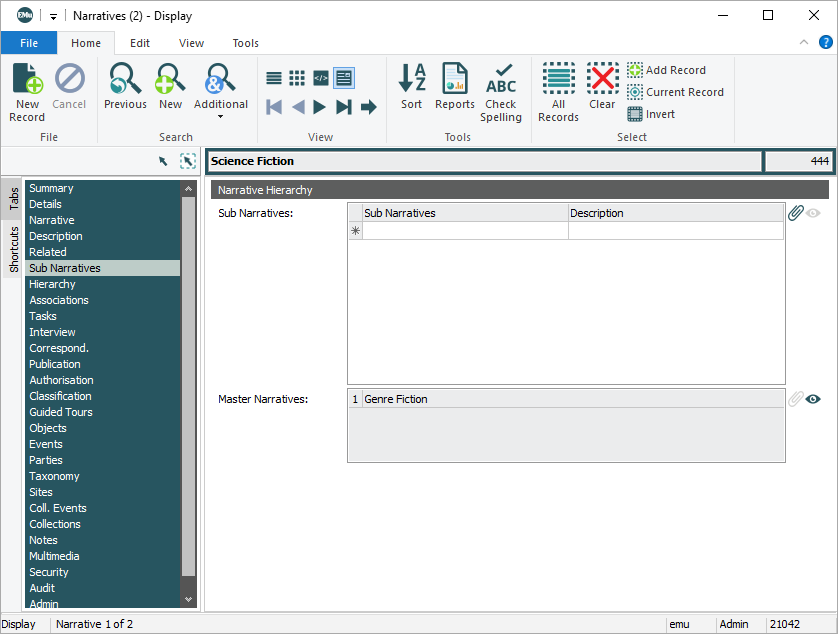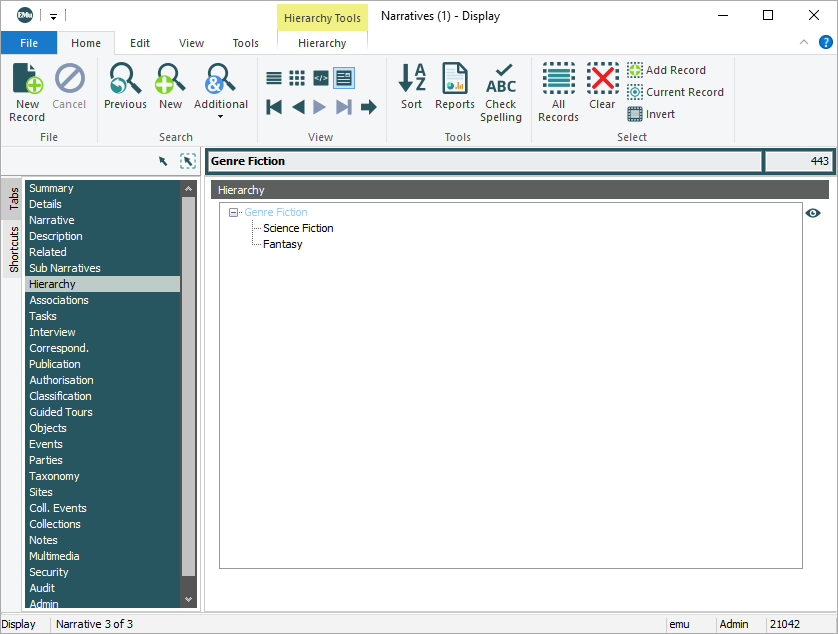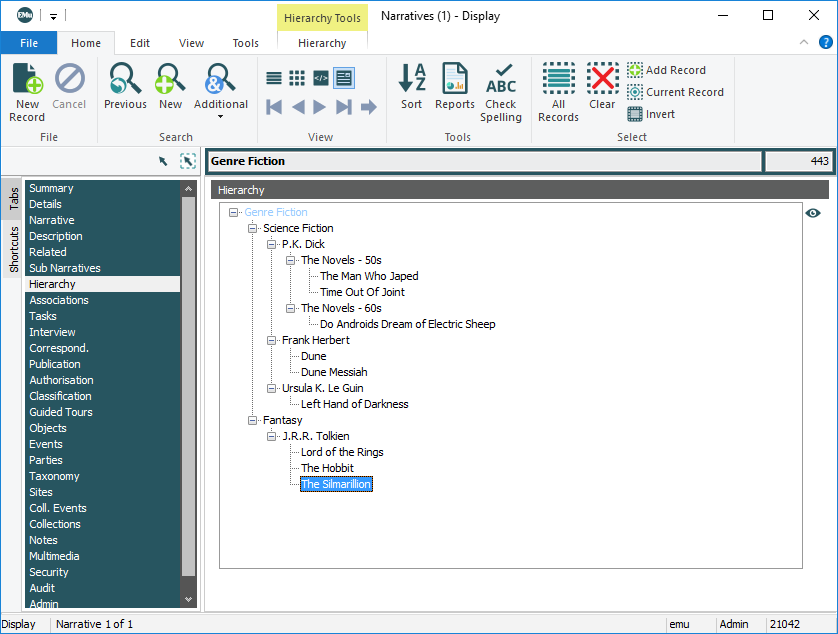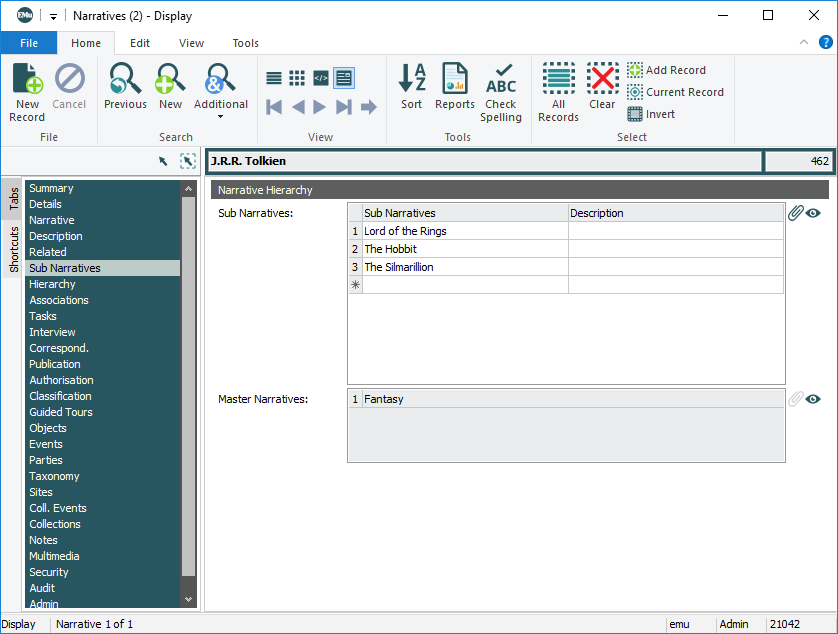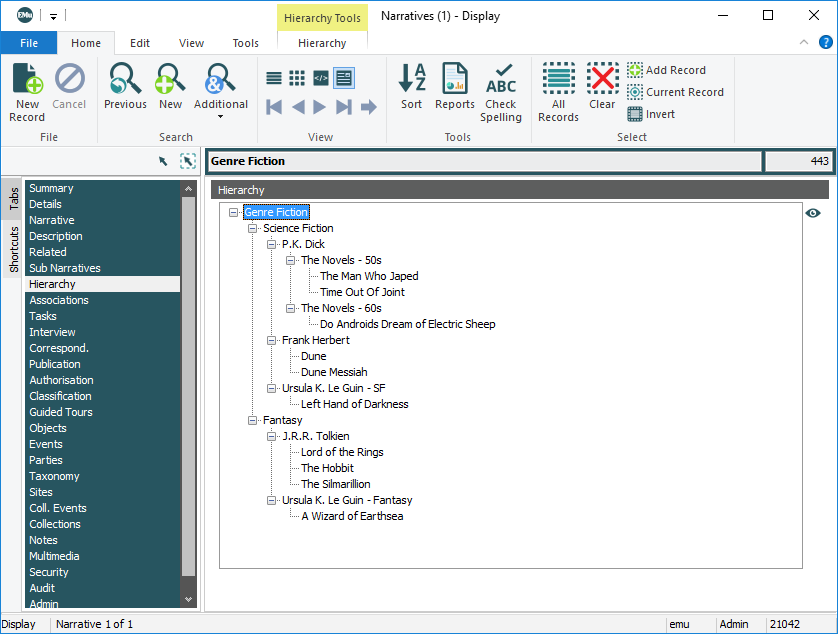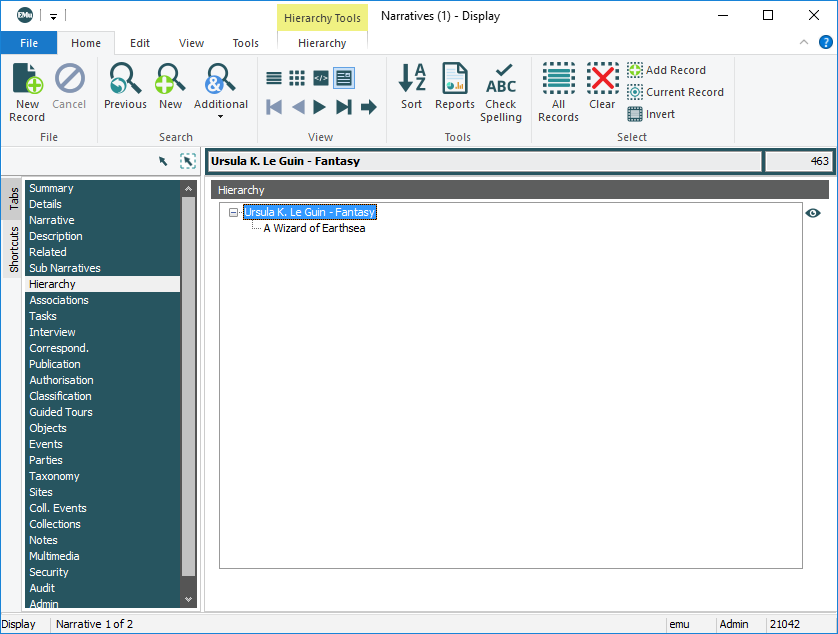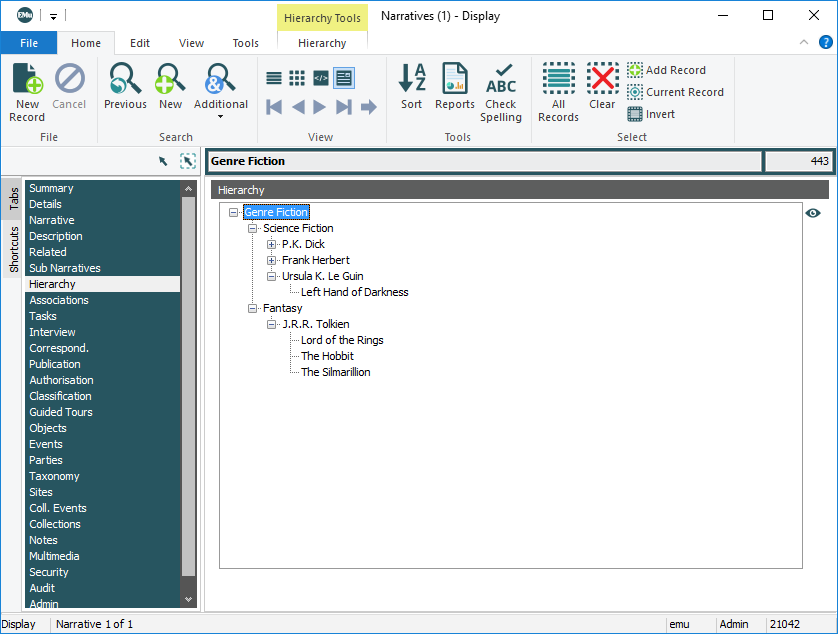The most straightforward approach to structuring your narratives is to arrange them in a hierarchy, commencing with an umbrella narrative and cascading down through logical groupings.
If we consider our example narratives, several ways to arrange them in a hierarchy may be apparent, but for the sake of illustration we structure them as follows:

In the Narratives module we establish these relationships on the Associations tab using the Related Narratives fields.
One of the beauties of this approach is that it is possible to view the full tree-like structure of narratives on the Hierarchy tab for any record included in the hierarchy.
Note that in the illustration the Narrative Type has been indicated for each record. For this collection, four Types in a simple hierarchy are deemed to be sufficient to categorize the narratives:
- Master
- Theme
- Category
- Story
Something to note is that the Type is not necessarily tied to a particular level in the hierarchy and, in fact, the hierarchy of narratives is not constrained by the hierarchy of Types.
Consider that we have four Types, but there are in fact five levels to the hierarchy of narratives.
In this example the Category type defines a broad grouping of narratives (although less broad than Theme). As can be seen the P.K. Dick narrative (which is a Category) points down to two more Category narratives: in other words, a Master narrative with a Type of Category (for example) does not need to point down to narratives with a Type of Story - it can clearly point to another Category, which in turn could point to further Category narratives.
In short, there could be as many levels as make sense for your collection.
Next steps
At the highest level in our example narratives is the Genre Fiction narrative: it is the only record in our hierarchy that does not reference a narrative higher than it. This narrative discusses the very broad topic of genre fiction.
Note: This narrative has been assigned a Type of Master.
We establish the relationship between a master narrative and its sub narratives on the Sub Narratives tab of the master record.
At this stage, and before we establish any of the relationships between our narratives, the Hierarchy tab for Genre Fiction appears as:
The next level in the hierarchy comprises two narratives, Science Fiction and Fantasy. Although still high level narratives these discuss the specific genres of science fiction and fantasy respectively.
Note: These narratives have been assigned a Type of Theme.
- On the Sub Narratives tab of Genre Fiction, attach the two sub narratives to the Sub Narratives: (Narrative Hierarchy) field.
Note: There are several ways to achieve this, the simplest of which is to enter details of a sub narrative, e.g. Science Fiction, in the Sub Narratives: (Narrative Hierarchy) field and press the TAB key. EMu searches the Narratives module using the details entered (see Attachments for more details).
The Sub Narratives tab of the Genre Fiction narrative record now looks like this:
Tip: The order of items in the Narrative Hierarchy table determines their order on the Hierarchy tab. As we see below, on the Hierarchy tab, Science Fiction appears above Fantasy in this example.
And the Sub Narratives tab of the Science Fiction narrative record now indicates that the Genre Fiction narrative is its Master Narrative:
And if we look at the Hierarchy tab, we find the following structure taking form:
In the same way, the Science Fiction narrative is made the Master Narrative for these records:
- P.K. Dick
- Frank Herbert
- Ursula K. Le Guin
Each of which is itself the Master Narrative for a number of others. Refer to the graphical representation of our hierarchy for details.
If you consider the steps we have taken thus far and examine the graphical representation of our hierarchy, a stumbling block may become apparent. Note that the Ursula K. Le Guin narrative is listed under two branches of the hierarchy: Science Fiction and Fantasy (Le Guin has written novels in both genres), but a narrative can clearly only have one Master Narrative.
Note: Using this method, it is not possible to locate a Narratives record in more than one place in a hierarchy.
As we'll see in A narrative can only have one Master: Part 2 there are a number of ways to deal with this.
For the moment we'll sidestep this issue and put aside the Ursula K. Le Guin records.
Assume that we have now established all of the relationships between the remaining narratives in our example. If we examine the Hierarchy tab for Genre Fiction, we find this:
This same structure can be viewed from any of the records in this hierarchy of Narratives records. You will note that the current record![]() The record currently displayed in Details View or highlighted in List View (there is a faint dotted line around it). It is only possible to have one current record at a time. is in blue text.
The record currently displayed in Details View or highlighted in List View (there is a faint dotted line around it). It is only possible to have one current record at a time. is in blue text.
If we look at the Sub Narratives tab for the narrative called J.R.R. Tolkien, we find that the Fantasy narrative is listed as its Master Narrative and three narratives are listed as Sub Narratives:
Which leaves the question of what to do with the Ursula K. Le Guin narratives. Three possible solutions present themselves:
One solution is to create two new narratives called, for instance:
- Ursula K. Le Guin - SF
- Ursula K. Le Guin - Fantasy
and locate them directly under the Science Fiction and Fantasy narratives (we'd give these a Type of Category). If we now complete the remaining relationships we would have the following hierarchy:
Another solution is to use the Associated With: (Associated Narratives) fields to create associations between narratives.
In this case we could:
- Make the Science Fiction narrative the Master Narrative for Ursula K. Le Guin.
- Make Ursula K. Le Guin the Master Narrative for The Left Hand of Darkness (a science fiction novel).
- On the Associations tab of the Ursula K. Le Guin narrative, attach a narrative called Ursula K. Le Guin - Fantasy in the Associated With: (Associated Narratives) table:
We could now establish a hierarchical relationship between Ursula K. Le Guin - Fantasy and any narrative records for fantasy novels by this author:
Or, Ursula K. Le Guin - Fantasy could be Associated With the narrative, A Wizard of Earthsea.
Although these associations will not show up on the Hierarchy tab:
these records are now linked together and it will be possible to navigate back and forth through them.
Furthermore, if these narratives are presented on a website, a user navigating to a page about Ursula K. Le Guin will find a See Also heading with a link to Ursula K. Le Guin - Fantasy.
Note: In this instance, this is not an ideal solution as we have arranged narratives by genre, but in many other situations this would be a suitable solution.
Alternatively we could build a different logical structure entirely that accommodates all our narratives. For example:


